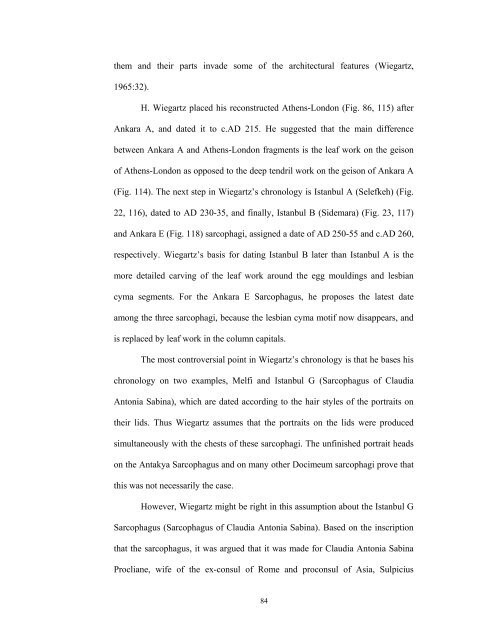To My Family and Uğraş Uzun - Bilkent University
To My Family and Uğraş Uzun - Bilkent University
To My Family and Uğraş Uzun - Bilkent University
Create successful ePaper yourself
Turn your PDF publications into a flip-book with our unique Google optimized e-Paper software.
them <strong>and</strong> their parts invade some of the architectural features (Wiegartz,<br />
1965:32).<br />
H. Wiegartz placed his reconstructed Athens-London (Fig. 86, 115) after<br />
Ankara A, <strong>and</strong> dated it to c.AD 215. He suggested that the main difference<br />
between Ankara A <strong>and</strong> Athens-London fragments is the leaf work on the geison<br />
of Athens-London as opposed to the deep tendril work on the geison of Ankara A<br />
(Fig. 114). The next step in Wiegartz’s chronology is Istanbul A (Selefkeh) (Fig.<br />
22, 116), dated to AD 230-35, <strong>and</strong> finally, Istanbul B (Sidemara) (Fig. 23, 117)<br />
<strong>and</strong> Ankara E (Fig. 118) sarcophagi, assigned a date of AD 250-55 <strong>and</strong> c.AD 260,<br />
respectively. Wiegartz’s basis for dating Istanbul B later than Istanbul A is the<br />
more detailed carving of the leaf work around the egg mouldings <strong>and</strong> lesbian<br />
cyma segments. For the Ankara E Sarcophagus, he proposes the latest date<br />
among the three sarcophagi, because the lesbian cyma motif now disappears, <strong>and</strong><br />
is replaced by leaf work in the column capitals.<br />
The most controversial point in Wiegartz’s chronology is that he bases his<br />
chronology on two examples, Melfi <strong>and</strong> Istanbul G (Sarcophagus of Claudia<br />
Antonia Sabina), which are dated according to the hair styles of the portraits on<br />
their lids. Thus Wiegartz assumes that the portraits on the lids were produced<br />
simultaneously with the chests of these sarcophagi. The unfinished portrait heads<br />
on the Antakya Sarcophagus <strong>and</strong> on many other Docimeum sarcophagi prove that<br />
this was not necessarily the case.<br />
However, Wiegartz might be right in this assumption about the Istanbul G<br />
Sarcophagus (Sarcophagus of Claudia Antonia Sabina). Based on the inscription<br />
that the sarcophagus, it was argued that it was made for Claudia Antonia Sabina<br />
Procliane, wife of the ex-consul of Rome <strong>and</strong> proconsul of Asia, Sulpicius<br />
84
















